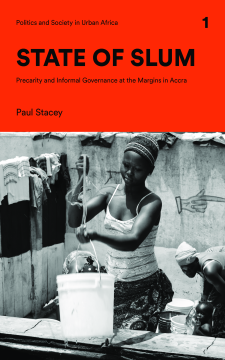
Additional Information
Book Details
Abstract
Home to eighty thousand people, Accra’s Old Fadama neighbourhood is the largest illegal slum in Ghana. Though almost all its inhabitants are Ghanaian born, their status as illegal ‘squatters’ means that they live a precarious existence, marginalised within Ghanaian society and denied many of the rights to which they are entitled as citizens.
The case of Old Fadama is far from unique. Across Africa, over half the population now lives in cities, and a lack of affordable housing means that growing numbers live in similar illegal slum communities, often in appalling conditions. Drawing on rich, ethnographic fieldwork, the book takes as its point of departure the narratives that emerge from the everyday lives and struggles of these people, using the perspective offered by Old Fadama as a means of identifying wider trends and dynamics across African slums.
Central to Stacey’s argument is the idea that such slums possess their own structures of governance, grounded in processes of negotiation between slum residents and external actors. In the process, Stacey transforms our understanding not only of slums, but of governance itself, moving us beyond prevailing state-centric approaches to consider how even a society’s most marginal members can play a key role in shaping and contesting state power.
Paul Stacey is a postdoctoral researcher in global development at the Institute for Food and Resource Economics, University of Copenhagen. He has undertaken research projects for Oxfam America, the Danish Institute for International Studies, and the Bill and Melinda Gates Foundation. This is his first book.
Table of Contents
| Section Title | Page | Action | Price |
|---|---|---|---|
| Cover | Cover | ||
| Title Page | iii | ||
| Copyright | iv | ||
| Dedication | v | ||
| Contents | vii | ||
| List of images | ix | ||
| Acknowledgements | xi | ||
| Introduction | 1 | ||
| Framing the study: the impromptu city | 6 | ||
| A brief outline of land law, government objectives and positions towards Old Fadama | 9 | ||
| Old Fadama: a political context of precariousness and uncertainty | 17 | ||
| Theoretical framework | 20 | ||
| Old Fadama as a case study | 26 | ||
| Conceptual and theoretical contributions | 29 | ||
| The wider context: urbanization and government dilemmas | 38 | ||
| Method considerations | 41 | ||
| Outline of the book | 45 | ||
| 1: Origins and destinations | 51 | ||
| A brief history of north–south divides | 51 | ||
| Contemporary northern Ghana: poverty levels, inequalities and economic growth | 54 | ||
| Cultural and ethnic contentions | 57 | ||
| Old Fadama: a brief history of contentions and drivers | 59 | ||
| Old Fadama: general living conditions | 62 | ||
| The environmental context | 64 | ||
| Demography | 66 | ||
| Conclusion | 67 | ||
| 2: Seeking shelter and freedom | 71 | ||
| Escaping social pressures and ethnic contentions | 72 | ||
| Freedom, ‘rightlessness’ and agency | 74 | ||
| Perceptions of government | 78 | ||
| To stay or to go? | 79 | ||
| George | 81 | ||
| Adjua | 85 | ||
| Conclusion | 90 | ||
| 3: Gaining and losing land, and soft property | 93 | ||
| Old Fadama: some drivers of long-term settlement | 98 | ||
| School building | 100 | ||
| Hotel building | 103 | ||
| Clawing back control and loss of power | 108 | ||
| Yaw | 108 | ||
| The wall: boundary-making and new opportunities | 113 | ||
| Changing claims, rights and spatial disparities | 119 | ||
| Conclusion | 122 | ||
| 4: Shifting yam and marketplace citizenship | 125 | ||
| Citizenship | 129 | ||
| Market organization and governance | 130 | ||
| Jemima | 135 | ||
| Pressure to move, promises to stay | 136 | ||
| Staying and going, and perceptions of difference | 142 | ||
| Conclusion | 146 | ||
| 5: Solving problems and emerging authority | 151 | ||
| Local government reform and the de facto government in Old Fadama | 155 | ||
| OFADA organization, membership and representation | 157 | ||
| Public tasks and the provision of services | 160 | ||
| Waste management | 162 | ||
| Regulation of building and construction | 164 | ||
| Policing | 166 | ||
| Hybrid authority and new subjectivities | 168 | ||
| External dynamics of recognition | 170 | ||
| Conclusion | 174 | ||
| Conclusions and policy perspectives | 177 | ||
| SDG perspectives | 179 | ||
| Faith in formal planning | 180 | ||
| Power | 182 | ||
| Local rights and the rule of law | 184 | ||
| Policy perspective | 187 | ||
| Notes | 191 | ||
| References | 197 | ||
| Index | 213 |
